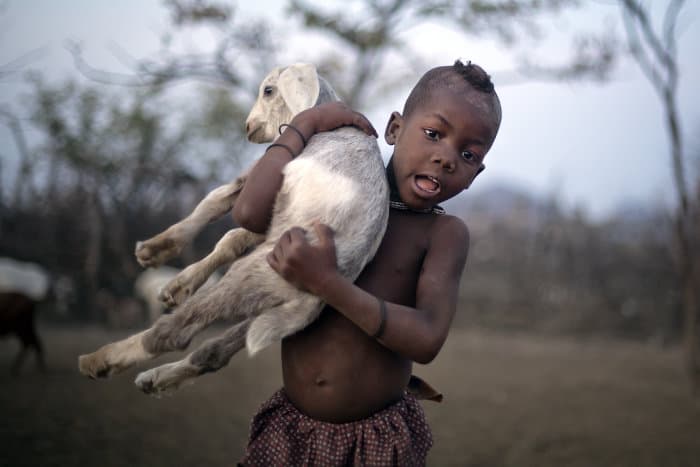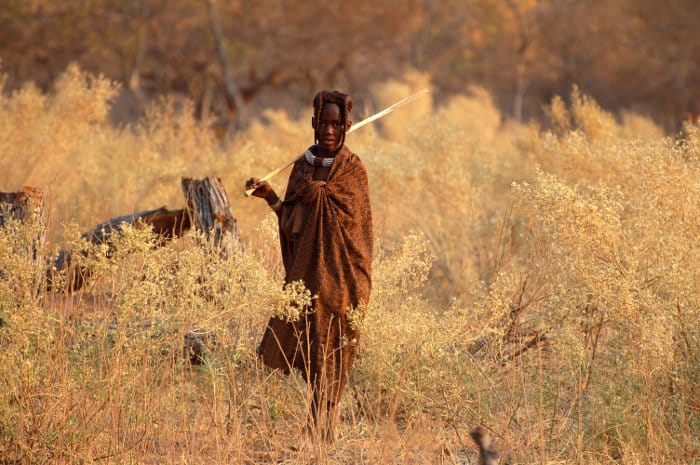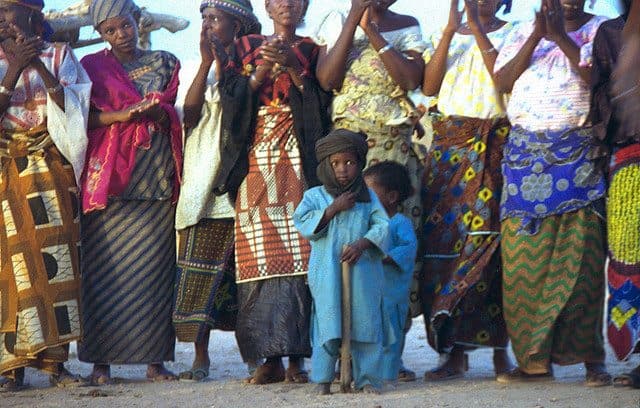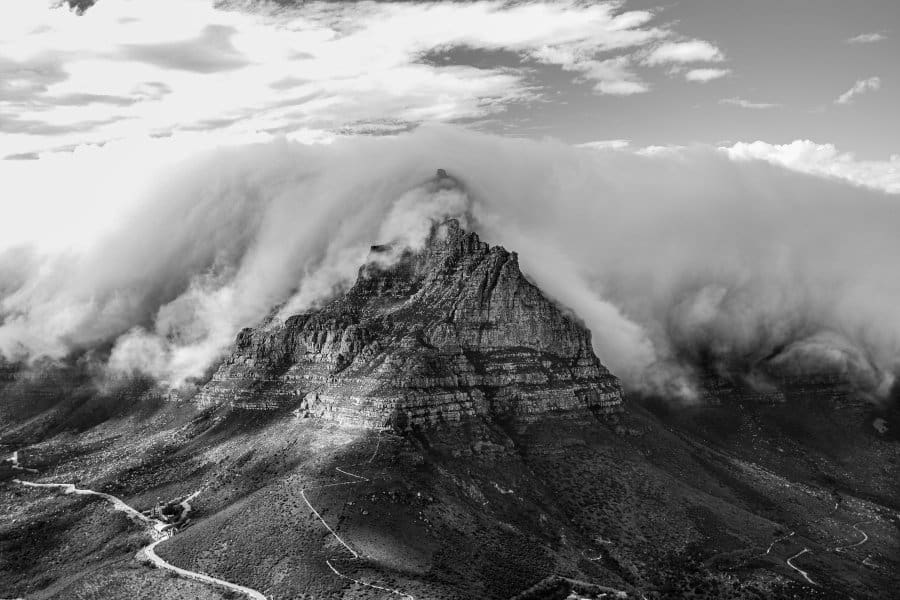Removed from Namibia’s capital city, you’ll find a way of life that seems so different from modern society. The Himba people are native to Namibia, with an estimated population of around 50,000.
Living on the northern side of the country, bordering Angola, they are the last nomadic people in the region. Although not all villages are nomadic.
Their predominantly itinerant lifestyle means that this tribe moves throughout the years in order to find green pastures for their livestock. Without their livestock, these people would struggle to flourish outside of modern-day living.
The Himba people hold a culture that geography, climate, and history shape. All of which has created a lifestyle completely unique to Namibia.
Origins of the Himba Tribe

The Himba people are part of a tribe that is closely related to the Herero, a Bantu ethnic group. Once part of the Herero tribe, the Himba separated themselves from the tribe at the end of the 19th century.
The people of the Himba tribe suffered with gorilla warfare, droughts, and German invasion in the area. The bovine epidemic, which killed the majority of their livestock, also forced the Himba to search elsewhere. For grazing grounds for goats, cattle, sheep, and to occupy new lands.
The holy fire and the connection with the ancestors
People who are part of the Himba tribe are animists. This belief system states that objects, places, and creatures possess a level of spiritual essence. Meaning that many things can be holy.
Their supreme God is Mukuru, and the village will communicate with their God through fire. Fire is sacred among the people and they use it to speak to God. The smoke helps to communicate with the ancestors, who provide a pathway to God.
The deep red ochre

Towards the north side of the country, people will journey to the mountains to retrieve ochre stones. Not every mountain holds this deep red stone that plays an iconic role in the Himba culture.
Surrounding villages will venture into the mountains to source this precious stone. A reddish-brown summit indicates that the ochre stone is present.
The gathers will then sell the stones to the Himba people. And ground up into tiny fragments with a mixture of butter, from either goat or cow, and applied to the skin. The red paste – known as otjize – acts as protection for the skin against the harsh sun, while also functioning as a moisturizer.

Just like everyone takes a daily shower, the Himba people use this traditional cream as a way to clean and smooth their skin. It’s also believed to heal the skin from wounds.
The women use the mixture on their hair as well. The paste coats the locks of their hair and protects the scalp from burning.
However, It’s not only done for a practical reason. There is beauty found in this aesthetic, with women using synthetic hair extensions coated in the stones cream.
Erembe crown
On top of the women’s ochre coated hair rests a Himba crown called Erembe. Made from goat or cow leather, this crown is a respected sign and worn by women once they have reached puberty.
Women wear their hair in a completely different style before reaching puberty, with the locks separated into two and braided. The two braids rest over the girl’s foreheads. Once she has matured, the girl can style her hair like the rest of her elders and get ready to become a real woman.
The Himba Women

Women in the Himba tribe perform highly intensive labor. This includes carrying barrels of water and chopping and carrying fire wood. They’re also in charge of preparing the majority of the meals cooked daily.
The elder women play a fundamental role in keeping the sacred fire burning, which protects the village against evil spirits.
The Himba men are in charge of the livestock and responsible for the animals’ slaughter and cleaning. However, meat isn’t a daily part of life here. A goat is usually killed for ceremonies, weddings, celebrations, and when children go through puberty.
A Traditional Himba Village
From a bird’s-eye view, the Himba village forms a large ring of mud huts. The chief’s house is usually the biggest and the rest of the community houses outline the circular town.
In the middle of the village is a round space for communicating with the ancestors and connecting with fire. This also serves as a pen for livestock, as they’re best protected from predators here.
Huts

The base of a Himba house is made of a mixture of water and cow dung. At the top of each circular hut, Mopane wood forms the roof.
The Himba tribe all sleep on cow skin, which acts as a mattress.
In the middle of the hut, you’ll find a small fire. As well as being useful for providing heat and insulation, the fires serve the purpose of being a steam shower.
Village food
Out in a remote Himba village, food is always made from scratch, with the people being dependent on the land.
Goat and sheep are the primary commodities in these tribes, although a cow in the village symbolizes wealth. A fascinating approach to killing the livestock is by stopping the airflow of the animal. This ensures that more blood remains in the body, providing a tastier, more nutritious meal.
Next, the chief will remove the animal’s insides and begin reading the tribe’s future. The belief is that the animal’s insides can reveal who will soon die or if there will be farming success this year. As well as any other kind of message that the tribe should hear.
A few other delicacies include mopane worms collected from the trees and left to dry in the sun. The worms are an excellent source of protein and energy for the tribe. They will boil the worms, then fry them and add them into the staple meal, maize porridge.
Life Without Water for the Namibian Himba Tribe

For 500 years, the Himba tribe and their ancestors have been surviving on minimal amounts of water. In today’s age and society, we often take clean, accessible water for granted.
With a shortage of water, there isn’t much of this life source to use for cooking and cleaning, nevermind daily showers.
So the Himba people have created a somewhat unique hygiene routine. They collect special branches and twigs and burn them to create smoke.
This smoke helps to clean the air as well as the tribe’s clothes and bodies. The special light smoke acts as a cleanser for the skin and works as a kind of perfume.
By using smoke to cleanse their bodies, the tribe saves on water. This act dates back to times of severe droughts, especially in the Kalahari desert.
Once the Himba tribe has run out of water, which has a detrimental effect on their livestock, they will move in search of more. Fresh water allows grasses to grow, which helps feed their goats and sheep.
Income for the Himba Tribe
While the Himba people mostly depend on the land resources, a large part of their income now comes from tourism. Many international visitors are fascinated by the tribe’s lifestyle and enjoy visiting the authentic villages.
Although this is an intrusive meeting, the tribe allows visitors to observe their way of life. And tourists can purchase some of the crafts and jewelry that the women create.
This extra income allows the lifestyle of the tribe to thrive when climate conditions are tough. Yet, there is a downside to this exchange.
Before the boost in tourism, the Himba tribe was mostly untouched by the outside world. This served as a way of protecting their culture and tradition. External influences are only going to increase, which could change the daily lifestyle of the Himba people.
Himba People: The African Tribe of the Desert

The Himba tribe is a group of people who can teach us so much about how the world works. They rely on the Earth for protection against the sun, the sustainable act of nurturing their animals and connecting with their roots.
We can look at this tribe and see how important it is to live off the land and cherish what the Earth can give us. Historically, these kinds of lifestyles have been lost due to globalization and modern amenities.
Although tourism is spreading across these villages, we can learn a lot from videos and articles. This form of learning can help keep these traditions untouched from crowds of people.
To appreciate the arid lifestyle, book a custom safari, and experience the desert firsthand.



